
The finback catsharks are a small family, the Proscylliidae, of ground sharks. They can be found in warm seas worldwide and are often the most numerous and common shark in tropical regions. They are generally less than 1 m in length, and are slow-moving predators that feed on bony fish and small invertebrates. Although some bear live young, the majority lay eggs with almost fully developed young; these egg cases, known as "mermaid's purses", are unique in appearance to each species.
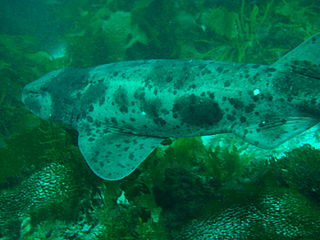
Cephaloscyllium is a genus of catsharks, and part of the family Scyliorhinidae, commonly known as swellsharks because of their ability to inflate their bodies with water or air as a defense against predators. These sluggish, bottom-dwelling sharks are found widely in the tropical and temperate coastal waters of the Indian and Pacific Oceans. They have stocky, spindle-shaped bodies and short, broad, and flattened heads. The mouth is capacious, containing many small teeth and lacking furrows at the corners. The two dorsal fins are placed far back on the body, with the first much larger than the second. Different species have various color patterns of saddles, blotches, reticulations, and/or spots. The largest members of the genus can grow over 1 m (3.3 ft) in length. Swellsharks prey on a variety of fishes and invertebrates, and are oviparous, with females producing egg capsules in pairs. They are harmless and have been deemed of having no commercial value.
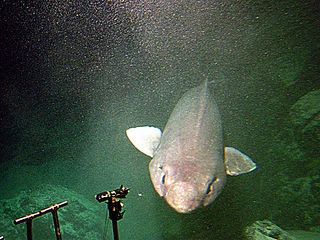
The false catshark or sofa shark is a species of ground shark in the family Pseudotriakidae, and the sole member of its genus. It has a worldwide distribution, and has most commonly been recorded close to the bottom over continental and insular slopes, at depths of 500–1,400 m (1,600–4,600 ft). Reaching 3.0 m (9.8 ft) in length, this heavy-bodied shark can be readily identified by its elongated, keel-like first dorsal fin. It has long, narrow eyes and a large mouth filled with numerous tiny teeth. It is usually dark brown in color, though a few are light gray.
The Pseudotriakidae are a small family of ground sharks, belonging to the order Carcharhiniformes, containing the false catsharks and gollumsharks. It contains the only ground shark species that exhibit intrauterine oophagy, in which developing fetuses are nourished by eggs produced by their mother.

The pygmy ribbontail catshark is a species of finback catshark, family Proscylliidae, distributed patchily in the western Indo-Pacific from Tanzania to the Philippines. It occurs around the edges of continental and insular shelves at a depth of 71–766 m (233–2,513 ft), typically on or near mud bottoms. One of the smallest living shark species, the pygmy ribbontail catshark grows to a maximum known length of 24 cm (9.4 in). It has a slender body with a low, ribbon-like tail fin, and is dark brown in color with blackish dorsal fin markings and tail bands. This shark feeds mainly on bony fishes, followed by crustaceans and then squid. It is aplacental viviparous with females bearing litters of 1–2 relatively large pups. It is of minimal significance to fisheries, being caught as bycatch in some areas.

Galeus is a genus of catshark, belonging to the family Scyliorhinidae, commonly known as sawtail catsharks in reference to a distinctive saw-toothed crest of enlarged dermal denticles, found along the upper edges of their caudal fins. They are found in the Atlantic, the western and central Pacific, and the Gulf of California, inhabiting deep waters at or close to the sea floor. Members of this genus are rather small, slim sharks with firm bodies and thick, rough skin. Their heads are usually fairly long and pointed, and have large mouths with well-developed furrows at the corners. They have large pectoral and anal fins, and two similar dorsal fins placed well back. Many species are ornately patterned with dark saddles and/or blotches. Sawtail catsharks feed on various invertebrates and fishes, and may be either egg-laying or live-bearing. These harmless sharks are sometimes caught as bycatch but are of minimal commercial value.
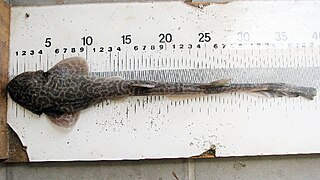
Holohalaelurus is a genus of catshark in the family Scyliorhinidae, commonly known as Izak catsharks or hallelujah sharks.
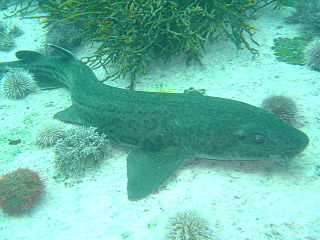
The leopard catshark is a species of catshark, and part of the family Scyliorhinidae, endemic to the coastal waters of South Africa. Abundant in inshore waters under 20 m (66 ft) deep, this bottom-dweller favors rocky reefs, kelp beds, and sandy flats. Growing to a length of 84 cm (33 in), the leopard catshark has a stout body with two dorsal fins placed well back, and a short head and tail. It is extremely variable in color and pattern, with individuals ranging from almost white to black and covered by diverse patterns of black spots, blotches, rosettes, and/or lines. The color pattern changes with age and some forms seem to be location-specific, suggesting the presence of multiple distinct, local populations. In the past, some of the more distinct color forms have been described as different species.

The narrowtail catshark is a catshark of the family Scyliorhinidae, found off the coasts of Honduras and Nicaragua, between latitudes 18° N and 10° N, at depths between 190 and 410 m. It can grow up to a length of 35 cm (14 in). The reproduction of this catshark is oviparous.

The dwarf catshark is a catshark, belonging to the family Scyliorhinidae. It is found off the coast of southern Florida, the Bahamas, and Cuba and is also known as the whitespotted catshark and Cuban catshark.

The quagga catshark is a species of catshark, belonging to the family Scyliorhinidae. A small, slim-bodied shark reaching 37 cm (15 in) in length, it has a distinctive color pattern of narrow, dark brown vertical bars, which resemble those of the quagga. Its head is short and flattened, with a pointed snout tip that is not upturned.

The speckled catshark is a catshark of the family Scyliorhinidae. It is found in the Gulf of Aden and off the coast of Somalia. It occurs at depths of between 37 and 250 m. Its length is up to 48 cm.

The dwarf sawtail catshark is a little-known species of catshark, belonging to the family Scyliorhinidae, found exclusively in the deep waters off Luzon in the Philippines. Unlike other members of its genus, this slender, diminutive shark has a short, rounded snout and very short furrows at the corners of its jaws. It has indistinct darker saddles beneath each dorsal fin and two dark bands on the caudal fin, as well as a prominent crest of enlarged dermal denticles along the upper caudal fin margin. The International Union for Conservation of Nature (IUCN) does not currently have sufficient information to assess the conservation status of this species.

The smallbelly catshark is a catshark of the family Scyliorhinidae found in the western Indian Ocean near Somalia, the Gulf of Aden, and Oman, at depths between 1,300 and 1,840 m. Its length is up to 34 cm, although this measurement is of an immature specimen. The smallbelly catshark is not well known. It is found on continental slopes, and is probably caught by bottom trawlers. The reproduction of the smallbelly catshark is oviparous.
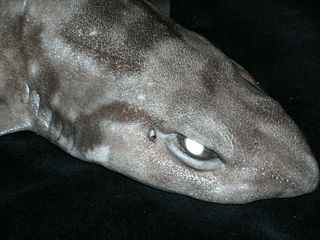
The blotched catshark is a little-known species of catshark, and part of the family Scyliorhinidae, found in the western central Atlantic Ocean. It inhabits banks of deep-sea coral at depths of 329–548 m (1,079–1,798 ft), feeding on cephalopods, shrimp, and bony fishes. This species can be identified by its wide body and head, and the dark saddle-like markings on its back. It also has small spots that fluoresce yellow under a blue light. Adult blotched catsharks have not been observed; the largest immature specimen is 49 cm (19 in) long. Like other catsharks, it is believed to be oviparous. This species is not dangerous to humans and has no commercial significance; the International Union for Conservation of Nature (IUCN) does not have enough data to assess its conservation status.
Planonasus is a genus of ground sharks in the family Pseudotriakidae, native to the western Indian Ocean.
The dwarf false catshark is a species of ground shark, which lives in the Indian Ocean near Socotra. This species is one of two known members of its genus, the other being the pygmy false catshark off the coast of India, Sri Lanka, and the Maldives.
Carcharhinus humani, also known as the Human's whaler shark, is a species of requiem shark, in the family Carcharhinidae. It inhabits the western Indian Ocean near the Socotra Islands, off Kuwait, Mozambique, and South Africa.















